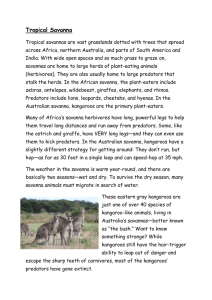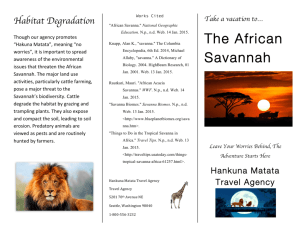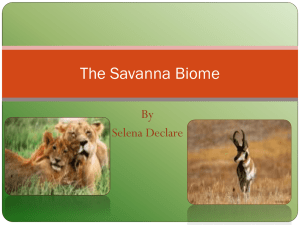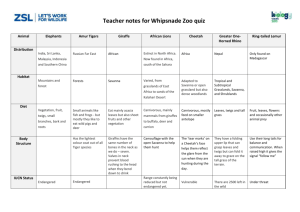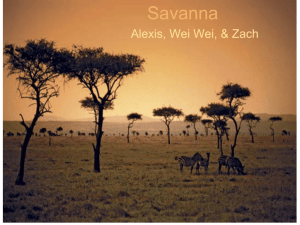Savanna Biome - Saint Joseph High School
advertisement
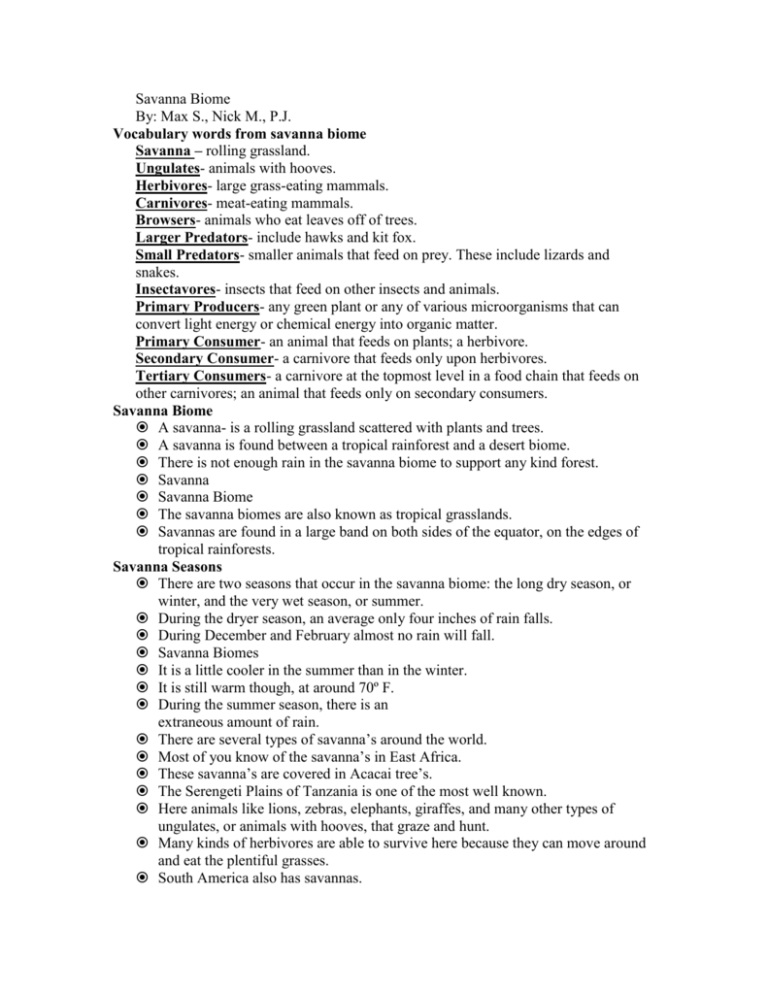
Savanna Biome By: Max S., Nick M., P.J. Vocabulary words from savanna biome Savanna – rolling grassland. Ungulates- animals with hooves. Herbivores- large grass-eating mammals. Carnivores- meat-eating mammals. Browsers- animals who eat leaves off of trees. Larger Predators- include hawks and kit fox. Small Predators- smaller animals that feed on prey. These include lizards and snakes. Insectavores- insects that feed on other insects and animals. Primary Producers- any green plant or any of various microorganisms that can convert light energy or chemical energy into organic matter. Primary Consumer- an animal that feeds on plants; a herbivore. Secondary Consumer- a carnivore that feeds only upon herbivores. Tertiary Consumers- a carnivore at the topmost level in a food chain that feeds on other carnivores; an animal that feeds only on secondary consumers. Savanna Biome A savanna- is a rolling grassland scattered with plants and trees. A savanna is found between a tropical rainforest and a desert biome. There is not enough rain in the savanna biome to support any kind forest. Savanna Savanna Biome The savanna biomes are also known as tropical grasslands. Savannas are found in a large band on both sides of the equator, on the edges of tropical rainforests. Savanna Seasons There are two seasons that occur in the savanna biome: the long dry season, or winter, and the very wet season, or summer. During the dryer season, an average only four inches of rain falls. During December and February almost no rain will fall. Savanna Biomes It is a little cooler in the summer than in the winter. It is still warm though, at around 70º F. During the summer season, there is an extraneous amount of rain. There are several types of savanna’s around the world. Most of you know of the savanna’s in East Africa. These savanna’s are covered in Acacai tree’s. The Serengeti Plains of Tanzania is one of the most well known. Here animals like lions, zebras, elephants, giraffes, and many other types of ungulates, or animals with hooves, that graze and hunt. Many kinds of herbivores are able to survive here because they can move around and eat the plentiful grasses. South America also has savannas. However there are very few species that live in these savannas. The savannas of Brazil, Venezuela, and Columbia make up nearly 2.5 million square kilometers, an area around the size of Canada. Animals of the African savannas Aardvarks are large mammals that eat ants. The African Elephant is the largest land animal. African wild cats are fierce, solitary hunters. Antelopes are graceful mammals with beautiful horns. Anteaters are mammals with very long snouts from South and Central America. The Asian Elephant is an endangered species. The baboon is a very large monkey with a long snout and large cheek bones. The Cheetah is the fastest animal on earth. The black caiman is a meat-eating reptile from South America that can be found on seasonally flooded savannas. A large constricting snake from South and Central America. Birds Most of the birds in the savanna have long legs and large wings so they are able to go on long migrations. Many of them burrow under ground to avoid the heat, but also to raise their young. The savanna is a perfect place for birds of pray such as vultures and buzzards. The wide open plains provide them with a crystal clear view of there prey. The hot air from the ground, updrafts them which allows them to keep soaring almost effortlessly. The ostrich is the largest bird. It can not fly but it runs very fast. The Red-billed Oxpeckeker is a bird that perches on large mammals in southern Africa. Other Animals Other animals include: the cape hunting dog, caracel, cheetah, eland, garanuk, giraffe, gnu, grant’s gazelle, hippopotamus, hyena, impala, jackal, kudu, leopard, lion, meerkat, oryx, ostrich, red-billed oxpecker, and many more. Vegetation of the Savanna Most of the vegetation in the Savanna is used for grazing. In some savannas, crops and subtropical fruits are cultivated. Plants of the savanna are highly specialized to grow in this environment for long periods of time without any rain. Most plants have long tap roots that are able to reach the deep water table. They also have thick bark to resist annual fires that occur. Most have trunks that can store water. Many have leaves that drop during the winter, or dry season, to conserve water. Many of the grasses have adapted so that the animals are discouraged to graze upon them. Some of the grasses are to sharp, or bitter for some animal to handle. The side benefit of these adaptations is that every species has food too eat. Different species will graze from different parts of the grass. Many grasses grow from the bottom up, so that the growth tissue does not get damaged by the grazers. Many plants of the savanna also have storage organs such as bulbs and corms for making it through the dry seasons. The savannah has a large range of specialized plants and animals. They all depend on each other to keep the environment in balance. There are over 40 different species of hoofed mammals that live in the savannas of Africa. The different herbivores provide a wide range of food for carnivores, like lions, leopards, cheetahs, jackals, and hyenas. Each species has its own preference, making it possible to live side-by-side and not be in competition for food. Animal Adaptations Desert animals include many kinds of insects, spiders, reptiles, birds, and mammals. They have adapted to heat as well as scarcity of water. Deer, foxes, wolves and other animals may visit a desert after a rainfall in search for food. Butterflies and bee’s, at this time, often arise from there pupa state to feed on flowers that bloom. The jackrabbit’s light- colored fur helps it blend into its surroundings, and its large ears help it to keep cool by giving off heat. Many small animals hide under rocks or big burrows and stay there during the day to keep cool, and escape the sun. Plant Adaptations Desert plants differ in the ways they adapt themselves to hot and dry environments. Some desert plants have a short life-cycle. When the rain comes, these plants sprout quickly, flower and die. Their seeds then will lie dormant in the soil, until the next rain enables them to germinate and bloom. Most desert plants grow very far apart from each other. The roots of these plants spread out and extend, so that each plant is able to get water in a large area of land. Other desert plants have that extend deep into the ground to obtain water from deep beneath the ground. There are many other adaptations that plants have made to survive in the savanna. Food webs A food web describes all the relationships of one animal or plant to the other members of the community. This is the food web for the savanna biome. The larger predators smaller predators plant eaters, and primary consumers primary producers. Thank you Mrs. Semmler for allowidng me to email this to you. The bibliography is in the format of a word document, but I am going to transfer Many desert plants have no leaves, or grow only very small ones. Most have chlorophyll in their stems. Desert plants are the primary producers. Animals that live in the desert feed on the plant’s seeds, flowers, and juicy bodies and leaves. Food webs The plant-eating animals are the primary consumers. These animals are small, and can get by on little food. The secondary consumers eat the plant-eaters.

